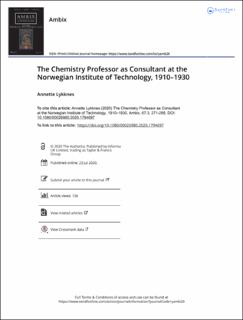| dc.contributor.author | Lykknes, Annette | |
| dc.date.accessioned | 2020-10-16T13:06:55Z | |
| dc.date.available | 2020-10-16T13:06:55Z | |
| dc.date.created | 2020-10-14T22:16:39Z | |
| dc.date.issued | 2020 | |
| dc.identifier.citation | Ambix. 2020, 67 (3), 271-288. | en_US |
| dc.identifier.issn | 0002-6980 | |
| dc.identifier.uri | https://hdl.handle.net/11250/2683394 | |
| dc.description.abstract | The Norwegian Institute of Technology (NTH) was established in Trondheim in 1910, shortly after the country had gained its independence from Sweden. The establishment of NTH coincided with the beginning of large-scale industry in Norway, and expectations were high as to what the Institute could contribute in terms of competence to establish new industries. Its professors were expected to be not just teachers or academics, but also to be involved in projects with industry. Consultancy was one way of exercising authority in relevant areas, and to acquire experience with industrial projects. Historical accounts about NTH often mention that its professors were consultants for industry, but what this entailed is rarely discussed. In this paper, I will investigate how two chemistry professors, appointed around 1910, formed their roles as consultants: Peder Farup, who experimented with the pigment titanium white for the successful company Elektrokemisk (now Elkem) in the 1910s; and Sigval Schmidt-Nielsen, who became the country’s authority on nutrition, and served both the state and the margarine industry as a consultant from World War I into the 1930s. I will argue that both Farup and Schmidt-Nielsen created “hybrid careers,” using a concept introduced by Eda Kranaki in 1992. | en_US |
| dc.language.iso | eng | en_US |
| dc.publisher | Society for the History of Alchemy and Chemistry | en_US |
| dc.rights | Attribution-NonCommercial-NoDerivatives 4.0 Internasjonal | * |
| dc.rights.uri | http://creativecommons.org/licenses/by-nc-nd/4.0/deed.no | * |
| dc.title | The Chemistry Professor as Consultant at the Norwegian Institute of Technology, 1910–1930 | en_US |
| dc.type | Peer reviewed | en_US |
| dc.type | Journal article | en_US |
| dc.description.version | publishedVersion | en_US |
| dc.source.pagenumber | 271-288 | en_US |
| dc.source.volume | 67 | en_US |
| dc.source.journal | Ambix | en_US |
| dc.source.issue | 3 | en_US |
| dc.identifier.doi | https://doi.org/10.1080/00026980.2020.1794697 | |
| dc.identifier.cristin | 1839702 | |
| dc.description.localcode | © 2020 The Author(s). Published by Informa UK Limited, trading as Taylor & Francis Group This is an Open Access article distributed under the terms of the Creative Commons Attribution-Non- Commercial-NoDerivatives License (http://creativecommons.org/licenses/by-nc-nd/4.0/), which permits non-commercial re-use, distribution, and reproduction in any medium, provided the original work is properly cited, and is not altered, transformed, or built upon in any way. | en_US |
| cristin.ispublished | true | |
| cristin.fulltext | original | |
| cristin.qualitycode | 1 | |

